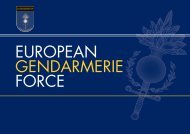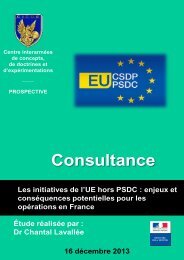Conference
science-research-bulletin-2013-conference
science-research-bulletin-2013-conference
Create successful ePaper yourself
Turn your PDF publications into a flip-book with our unique Google optimized e-Paper software.
EUROPEAN POLICE SCIENCE AND RESEARCH BULLETIN<br />
SPECIAL CONFERENCE EDITION<br />
also seek leniency and understanding when they<br />
themselves are under scrutiny. In this perspective<br />
the irrefutable requirements of governance by<br />
regulation paradoxically undermine the street<br />
performance of the police officers, which it is<br />
meant to increase.<br />
Trusting that the police do their job in a fair and<br />
right way, not at least from a citizen protester’s<br />
perspective, is also the core theme of David<br />
Waddington’s case study of ‚softer’ tactics of<br />
policing political protest in South Yorkshire, UK.<br />
In his essay he traces dialogue-based police tactics<br />
that recently surfaced in Europe, like the Swedish<br />
inspired GODIAC project, back to concepts that<br />
were already applied in metropolitan London<br />
20 years ago and describes in detail how this<br />
approach unfolds in practice. While he recognises<br />
the positive results in form of a bigger chance<br />
for civilised encounter between protesters and<br />
police forces and the building of rapport in the<br />
long-term, he stresses that the (mutual) trust<br />
goes only so far and that those tactics are not<br />
appreciated from all sections of the police force,<br />
where some favour still a more traditional robust<br />
approach.<br />
The robust side of policing and its meaning for the<br />
contemporary self-understanding and training of<br />
police professionals is as well the topic of Rafael<br />
Behr’s contribution from Germany, a turned into<br />
teaching academic former operational police<br />
officer. Relating to a public debate in Germany<br />
on violence against the police, he aims at an<br />
enhanced understanding of violent police-citizen<br />
encounters by examining the interpretative<br />
dynamics on both sides. His hypothesis is that<br />
the probability of violence increases, triggered by<br />
a growing estrangement between the police and<br />
marginalised parts of the society, where especially<br />
younger police officers are not equipped with<br />
sufficient knowledge about using alternatives<br />
to force, when dealing with people in social<br />
or economic poverty. Admitting that a sound<br />
empirical base to underpin his hypothesis is still<br />
to be found, he calls for scientific examination<br />
to steer public debates away from the risks of<br />
hysteria and hype.<br />
In democratic societies, where the rule of<br />
law prevails and the respect for fundamental<br />
human rights is enshrined in legislative as well<br />
as in executive practices, citizen’s suffering from<br />
unjustified police violence or misconduct will be<br />
given recourse to legal remedies. The analysis of<br />
the development of police complaint procedures<br />
in England and Wales by Dermot Walsh provides<br />
little optimism that those instruments are fully<br />
fit to instil confidence of the concerned public<br />
in the soundness and functioning of a balanced<br />
policing system, as he identifies five structural<br />
weaknesses in addressing individual legal cases.<br />
One could understand the existence and work<br />
of Amnesty International as an institutionalised<br />
response of civil society insisting on good,<br />
human-rights compliant, non-discriminatory<br />
policing. Anja Bienert from the Dutch AI section<br />
describes in her contribution the progress that<br />
has been made in dialogue with police authorities<br />
so far, while highlighting areas in further need of<br />
improvement.<br />
An encouraging positive example, how a wellconsidered<br />
police training programme can<br />
underpin the formation of a positive relationship<br />
to populations at the fringe of established societies<br />
is delivered by the description of a community<br />
policing approach for Roma communities in<br />
Slovenia. Branko Lobnikar demonstrates how<br />
the introduction of special training programme<br />
on “policing in a multi-ethnic community” at<br />
police academy reaped benefits by significantly<br />
increasing the trust in proper police conduct and<br />
police procedures among influential members of<br />
the Roma community.<br />
The significance of trust - and its strong<br />
connection with perceived legitimacy of both<br />
police actions as well as police procedure systems<br />
- has been the central analytical focus of three<br />
contributions:<br />
• For a comparative analysis among eight<br />
countries in Central Eastern Europe, Gorazd<br />
Meško, Chuck Fields, Jerneja Šifrer and Katja<br />
Eman issued a web-questionnaire to a<br />
sample of law-students, inquiring about their<br />
perception of police authority and procedural<br />
justice, applying various statistical analysis<br />
methods to the outcomes.<br />
• Restricted to Germany, but based on a<br />
much broader population sample, Mai Sato,<br />
Rita Haverkamp and Mike Hough looked into<br />
the reasons, why trust in the police and<br />
police procedures are higher in Germany,<br />
compared to the European average data<br />
set. Interestingly, they found that there were<br />
no significant differences between ‘native’<br />
Germans and those respondents with a<br />
migration background.<br />
5





